When a magazine hands you an assignment to write about dim sum, you better be prepared to eat a lot of it. San Francisco magazine asked me to write an informative A to Z guide to dim sum as well as a short list of the best dim sum and dumpling spots in the city. In order to be authoritative, correct, and on top of things, I set out to eat. My dumpling adventure spanned two separate days. On day one, I ate at three (3) dim sum restaurants and bought takeout dim sum from a fourth. On day two, I went to three (3) takeout dim sum shops, a bakery, and five (5) dumpling joints.
I dined by myself. Dim sum and dumplings are a solitary or group food that you can eat any time of day. I ordered judiciously from each spot to sample a broad variety of items.
Not wanting to waste, I brought a cooler with me in the trunk of the car to stash leftovers. Leaving food at an Asian restaurant is preposterous. That’s what Chinese takeout boxes are for! On each of the dim sum days, I came home with a loaded cooler.
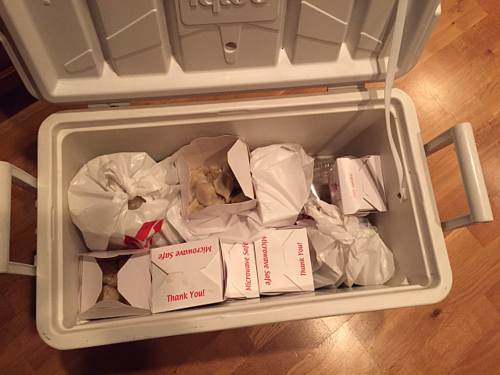
My husband Rory knew that dinner was basically made. Add a salad or stir-fried green vegetable and we had a dumpling party. Never have I reheated so many dumplings and dim sum. I learned a lot about how to transport and refresh pre-cooked dumplings.
Transporting dumplings requires simple logic. The waiter at Yank Sing assured me that he had packed my leftovers carefully. “Things are separated,” he volunteered with the tone of an experienced dim sum valet or butler. Yank Sing is a swank spot in San Francisco.
Back at my car, I took a look and sure enough, he’d done as promised. That totally made sense — steamed and fried should not be in one container or something would get soggy. Saucy and dry dishes should not rideshare in the same container. Savory and sweet should not commingle.
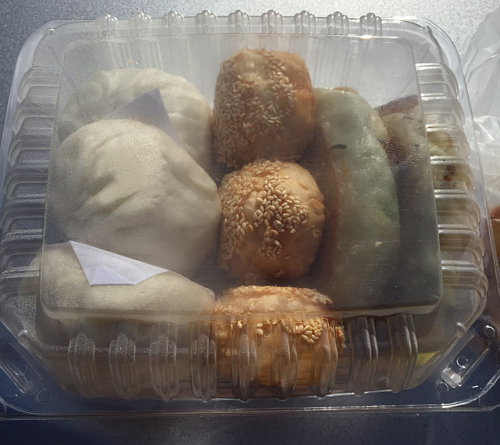
I also realized that if unless you’re traveling a long distance or it is super hot outside, baked or fried items can be kept at car temperature. I put steamed and stir-fried items in the cooler with ice packs. The drive from San Francisco to Santa Cruz is roughly 1 ½ hours.
Reheating room temperature dumplings is easiest because you’re doing little to disrupt their potentially fragile skins. My rule is that delicate steamed dumplings – har gow, for example, are best resteamed over water. Siu mai are little toughies, so they can go into a steamer or microwave oven. I put Crystal Jade Jiang Nian’s kurobuta pork siu mai in the steamer; they were expensive and reheated to 90% of their original, incredible selves.
Boiled northern Chinese dumplings were zapped in the microwave oven. I didn’t need to replicate their cooking method. I could have steamed them, but my large bamboo steamer tray was very full. Steamed bao (stuffed buns) could be resteamed over water or wrapped in damp paper towel and microwaved to fluffy freshness.
Panfried dumplings, such as pot stickers or Shanghai bao, were quickly re-panfried with a little oil and water to refresh them to a crisp, chewiness. There was breakage of the skin at the restaurant so those didn’t do well in reheating.
Dim sum encased in pastry are pretty durable. They were reheated on a rack in a 350F (180C / gas mark 4) oven for about 15 minutes, or until hot and gently sizzling. The perfect taro puffs (wu gok) from Hong Lounge 1 regained their beehive, crisp texture in the oven too. Pastries encased in sticky rice type of dough became leaden during reheating. No bueno.
Egg custard tarts and Portuguese egg tarts? I slid them on the rack and turned off the oven. That approached allowed them to refresh while we ate dinner. When it was time for dessert, I presented Rory an assortment of warm egg tarts.
So be not afraid to over order at dim sum or to buy takeout. You can bring them home and enjoy them practically like new.
Related posts and links:
- A to Z of Dim Sum (in San Francisco magazine, April 2015)
- How to Make Dumplings Efficiently: Workflow and Freezing Tips













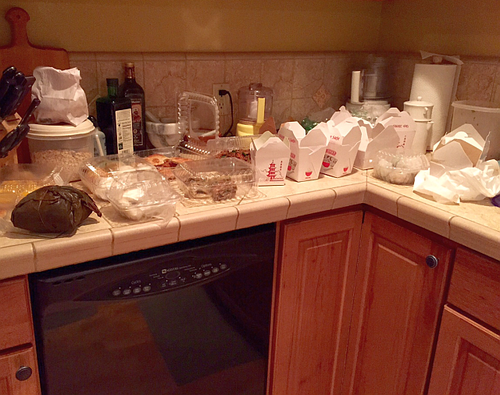
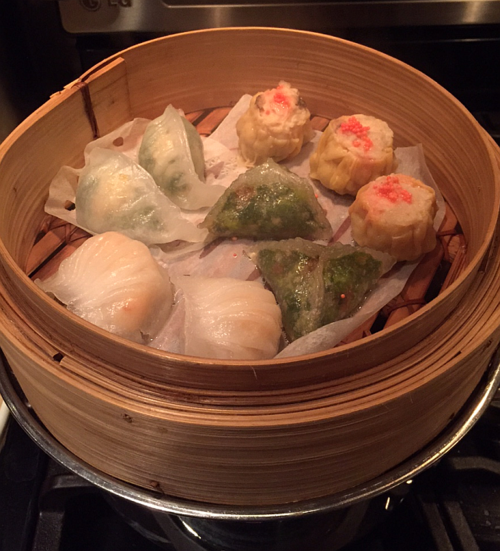
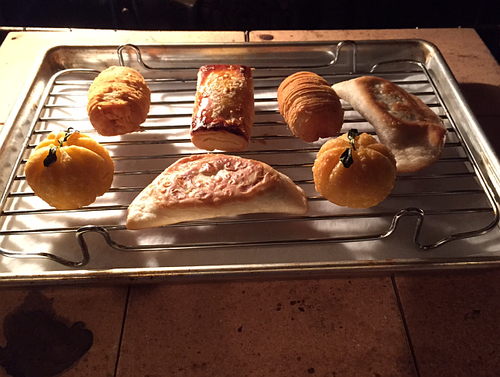
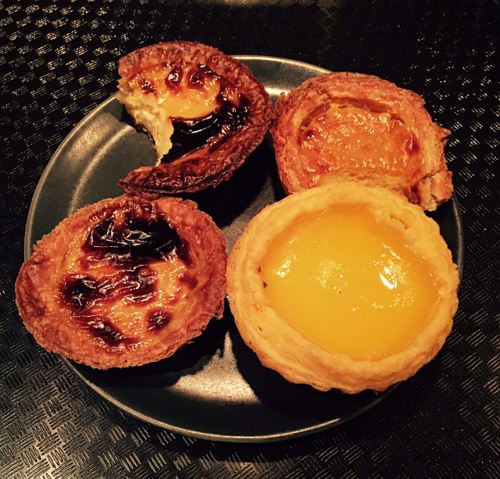




kaliki says
how long do i reheat on my bamboo steamer, n do i put the lid on it? its 1 bowl. in IPOT.
Andrea Nguyen says
4 to 6 minutes, usually. But it depends on the item, its size and how cold it is from the fridge.
kaliki says
how long do i reheat in my bamboo steamer pork cooked dim sum w tofu. n do i put the lid on it? its 1 bowl. in IPOT.
Andrea Nguyen says
I don't use an Instant Pot to steam in. Maybe try 2 minutes and go from there?
Andy B. says
Hi Andrea,
I tried to e-mail you through your Viet World Kitchen website before but did not receive a response, but I am nearing the time when I need to reheat my frozen dim sum food I took to-go due to the water fast I am almost done with. I wasn't sure if you read comments from posts you published long ago, but I'll go ahead and give it a try. I read through this article and now have an appropriate plan to reheat the ha cao and siu mai, but as far as the "khoai mon chien" and the "fried crab puffs", I do not have an oven, nor a traditional kitchen for that matter. Can I do anything with a hot plate or an Instant Pot to reheat them in an oven-like environment? From a fellow Vietnamese to another, please help me. Thank you.
Andrea Nguyen says
Hello Andrew,
I did not receive your email query from earlier. You can use a toaster oven for fried items and the steam function in the instant pot. Sounds like you live in a small apartment or a dorm room? You could grill the fried items but that would be hard. Or, use a skillet on the hot plate and medium low heat. Your food will not be "perfect" but they'll sort of be refreshed. Does that help?
Andy B. says
Hi Andrea,
Oh yes, it definitely helps. I'll try to resteam the khoai mon chien and crab puffs with the Instant Pot then. I'll probably dump them along with the ha cao or siu mai. I live in a house, but my room is locked out from the rest of the house and I have a private entrance. It is nice to get help from Bay Area Vietnamese. Thank you so much!
Andy B. says
Hi Andrea,
I was also wondering, is it possible that the exterior of the khoai mon chien, the crab puffs, and the shrimp ball dim sum with the crunchy wavy textures outside may taste mushy when resteaming them? Would it be a good idea to resteam those first, and then place them in a small pot with hot olive oil to refry the the outside at least? I don't have any other oil besides olive oil, and I do not want to go out and get vegetable oil just for this purpose. I'm hoping olive oil will do just the job; I'm using whatever is lying around to accomplish reheating my food as close to how they were initially served as possible. Please let me know if that sounds okay. Thank you.
-- Andy B.
Andrea Nguyen says
Andy -- I don't know and I wouldn't reheat/refresh deep-fried dim sum in the manner that you mention. It never hurts to try! Seriously. Strong extra virgin live oil had a flavor that may impact the food so be aware of that.